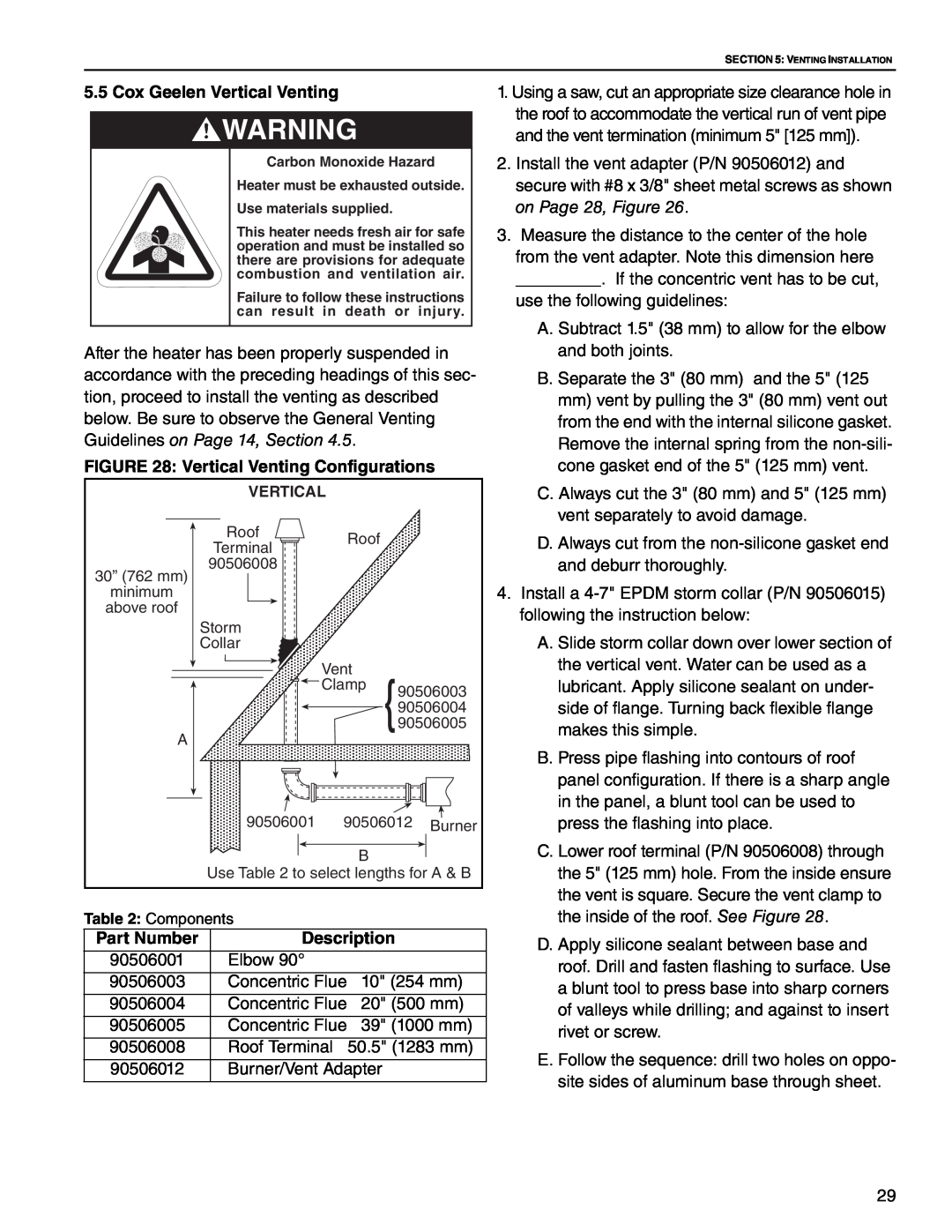
SECTION 5: VENTING INSTALLATION
5.5Cox Geelen Vertical Venting
![]() WARNING
WARNING
Carbon Monoxide Hazard
Heater must be exhausted outside. Use materials supplied.
This heater needs fresh air for safe operation and must be installed so there are provisions for adequate combustion and ventilation air.
Failure to follow these instructions can result in death or injury.
After the heater has been properly suspended in accordance with the preceding headings of this sec- tion, proceed to install the venting as described below. Be sure to observe the General Venting Guidelines on Page 14, Section 4.5.
FIGURE 28: Vertical Venting Configurations
| VERTICAL |
|
| |
| Roof | Roof |
|
|
| Terminal |
|
| |
|
|
|
| |
30” (762 mm) | 90506008 |
|
|
|
|
|
|
| |
minimum |
|
|
|
|
above roof |
|
|
|
|
| Storm |
|
|
|
| Collar |
|
|
|
|
| Vent |
|
|
|
| Clamp | 90506003 | |
|
|
| ||
|
|
| 90506004 | |
A |
|
| 90506005 | |
|
|
|
| |
| 90506001 | 90506012 | Burner | |
|
| B |
|
|
| Use Table 2 to select lengths for A & B | |||
Table 2: Components
Part Number | Description | |
90506001 | Elbow 90° |
|
90506003 | Concentric Flue | 10" (254 mm) |
90506004 | Concentric Flue | 20" (500 mm) |
90506005 | Concentric Flue | 39" (1000 mm) |
90506008 | Roof Terminal | 50.5" (1283 mm) |
90506012 | Burner/Vent Adapter | |
1.Using a saw, cut an appropriate size clearance hole in the roof to accommodate the vertical run of vent pipe and the vent termination (minimum 5" [125 mm]).
2.Install the vent adapter (P/N 90506012) and secure with #8 x 3/8" sheet metal screws as shown on Page 28, Figure 26.
3.Measure the distance to the center of the hole from the vent adapter. Note this dimension here
_________. If the concentric vent has to be cut, use the following guidelines:
A.Subtract 1.5" (38 mm) to allow for the elbow and both joints.
B.Separate the 3" (80 mm) and the 5" (125 mm) vent by pulling the 3" (80 mm) vent out from the end with the internal silicone gasket. Remove the internal spring from the
C.Always cut the 3" (80 mm) and 5" (125 mm) vent separately to avoid damage.
D.Always cut from the
4.Install a
A.Slide storm collar down over lower section of the vertical vent. Water can be used as a lubricant. Apply silicone sealant on under- side of flange. Turning back flexible flange makes this simple.
B.Press pipe flashing into contours of roof panel configuration. If there is a sharp angle in the panel, a blunt tool can be used to press the flashing into place.
C.Lower roof terminal (P/N 90506008) through the 5" (125 mm) hole. From the inside ensure the vent is square. Secure the vent clamp to the inside of the roof. See Figure 28.
D.Apply silicone sealant between base and roof. Drill and fasten flashing to surface. Use a blunt tool to press base into sharp corners of valleys while drilling; and against to insert rivet or screw.
E.Follow the sequence: drill two holes on oppo- site sides of aluminum base through sheet.
29
